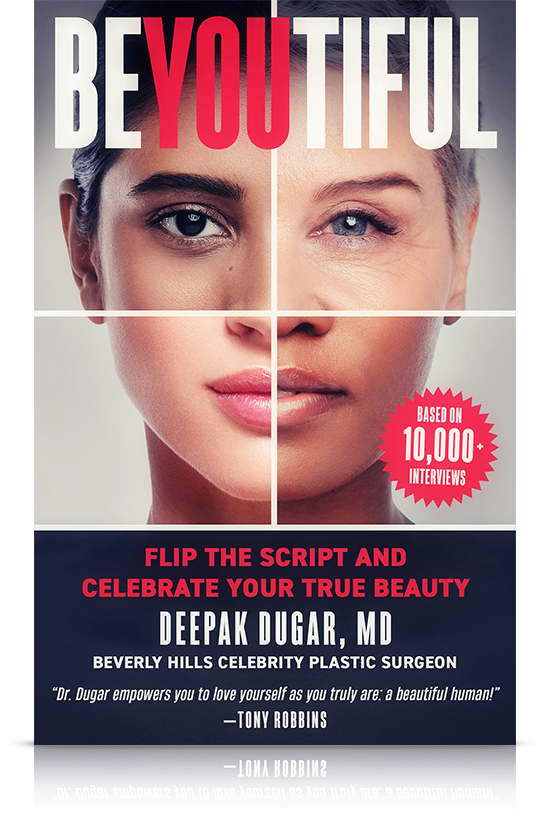Nearly everyone has admired the beauty of a flower.
But have you ever broken down the schematics of said flower and thought that the arrangement of the petals, or the color, or the shape must be why you considered it beautiful? Of course not, because that would be absurd.
Yet human beauty has been broken down in such a way. Researchers at the University of California in San Diego and the University of Toronto discovered that the distance between the centers of a woman’s eyes affects whether she is considered beautiful.
“People find her most attractive when that distance is just under half of the width of the face. Just as important, they found, is the distance between a woman’s eyes and mouth. It should be just over one-third the height of her face.” (Source: https://pubmed.ncbi.nlm.nih.gov/15085778/)
I tell my patients that those formulas are nonsense. True beauty all comes down to perception. What you perceive to be beautiful is beautiful…to you.
But the reverse is also true about the perception of ugly.
Each of us tries to align with our own perception of beauty; however, many of us fall short of our own perceptions, which leads to feeling ugly, or at least unattractive. We all externalize our perceptions of beauty based on other people’s perceptions of beauty rather than actually internalizing our own concepts of beauty.
Beauty Perceptions Through History
During the eras of Ancient Greece, the Italian Renaissance, and Victorian England, the “rounder” woman was considered the ideal body shape. The standard of beauty praised by Anglo-Saxon poets of the Middle Ages was a pale complexion so sought after that some women actually bled themselves regularly to achieve it!
However, the most prevalent perception of beauty became the Westernized concept propagated through media, film, magazines, and social media. Everyone in the world is enamored with Western beauty. But even Western perceptions of beauty have changed through the decades.
In the 1920s, the slim, androgynous look of the flapper was considered beautiful. That gave way to the hourglass figure of the 1930s through the 1950s, only to reappear in the 1960s when models like Twiggy set the beauty standard with her “twiggy” figure, pale lips, and heavily made-up eyes.
The 1970s showcased beauty in terms of the Farrah Fawcett-style suntan, “wings” hairdo, glowing smile, and slim-yet-curvy body. By the 1980s, the beauty standard was big, permed hair with mile-high bangs etc.
On and on, thorough the decades, and even within the decades, perceptions of beauty are always shifting. Anyone who tries to constantly adjust their appearance to always be perceived as beautiful is fighting a losing battle.
What—and Who—Shapes our Perceptions of Beauty?
While our beauty perceptions have been partially shaped by culture since the beginning of time, culture is shaped a great deal by the media.
The first beauty and fashion magazine Harper’s Bazaar was published on November 2, 1867, claiming to be “a repository of fashion, pleasure, and instruction.” Television began to shape our beauty perceptions through the beautiful actors and actresses on the programs and through the advertisements for beauty, fashion, and health products.
The biggest media influence on our beauty perceptions today is social media. In fact, it has become such a shaping factor in (false) beauty perceptions, I often specifically discuss how to filter that voice with my patients.
If they are looking at images of stereotypically beautiful people and feel ugly afterward, they need to understand and acknowledge that it affects their energy and self-esteem, and make liberal use of the “unfollow” option.
Voices Closer to Home
After culture, the real-life people we hang out with are the biggest influencers on our perceptions of beauty—romantic relationships, friends, and family—usually in that order.
Romantic relationships are a huge factor in defining how beautiful you feel and how confident you are. Even if you don’t think you align with cultural beauty standards, knowing someone you care about thinks you’re beautiful will often mean more.
Friendships are the next most influential in shaping our beauty perceptions. If you’re friends with people who are uplifting about how amazing and beautiful and great you are, you likely feel confident and energized being around them.
But if you are around people making you more self-conscious about the way you look or dress on a daily basis, this could easily bring your energy and confidence down. That’s when you may realize you may need to filter some real-life people from your life and not only on social media!
Family members are probably the least influential voices we listen to when it’s a positive comment, but paradoxically these voices can be the most influential when it comes to negative comments.
Healing from our childhood traumas and any damage to our self-esteem by our family is a huge part of growing into the beautiful beings we strive to be.
Remember that whether it’s your partner, friends, or family, all of their perceptions of beauty were influenced by the perceptions of their partners, friends, and families as well.
It’s not easy to break free from the prison of others’ perceptions, but ultimately, what I want for all of my patients (and for you!) is to look in the mirror and acknowledge what is beautiful about the person looking back at you.



